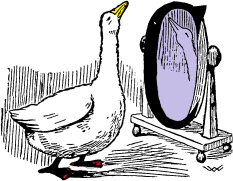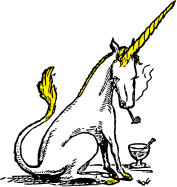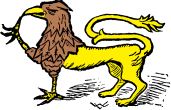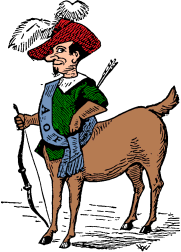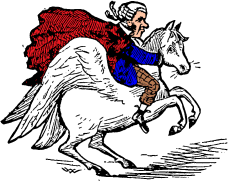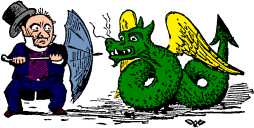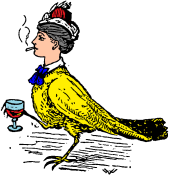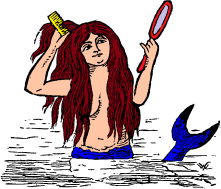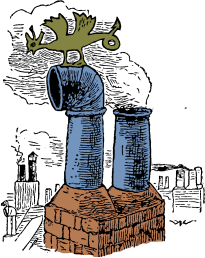HOME
Preface
Introduction
1
2
3
4
5
6
7
8
9
10
11
12
13
14
15
16
17
18
19
20
21
22
23
XIII
CHAPTER XIII.
OF CHIMERICAL FIGURES.
HIMERICAL Figures are the last and most ancient kind of charge to be found in Heraldry, and represent a variety of figures which never did, can, will, shall, might, could, or should exist in any zoological collection in the whole world.
Chimerical animals are a sort of Heraldic half-and-half, being generally compounded of half of one animal and the rest from another quite different, with very often a dash of a third, just to make the mixture more mixed, and confusion worse confounded. In fact, when in a Chimerical frame of mind, the Heralds as often as they got hold of an animal or two to serve up in their Heraldic dishes, invariably made a hash of them.
With the exception of Griffons, Martlets and Unicorns, these figures are of foreign origin, a great number coming over with the conquering hero William the First; that French "Bill," which our Saxon forefathers were compelled to accept at sight, and on his own demand. The bland way in which the conquering hero walked first into England, and then into the English, including most of their possessions, was a thing to be remembered by the sufferers. In fact they did remember it--those who were left--especially when they saw the Norman intruders taking possession of their Saxon estates with an open handed freedom that, however enjoyable to the takers, was less so to the takees. Still, let byegones be byegones; and far be it from us to rake up old grievances, especially since, so far as he knows, the author did not suffer by them to any great extent. Perhaps his not having been born at that time had something to do with this fact.
Anyhow, to return to our Chimerical Figures--
First of all we will commence with the Unicorn, which represents a horse with the tail of a lion, and a single horn in the middle of his forehead. He is of course familiar to all our readers, not only as one of the Supporters of the Arms of England, but also as an early, though unsuccessful competitor for the crown of this country. What he would have done with it had he obtained it, history does not say ; in fact, with all due deference to the legend in question, we fear we must relegate it to the category of things which never happened. Anyway, looking at the present shape of the head-piece in question it would have had to be considerably altered before it would have fitted his peculiar conformation of head; but as he did not get it, but only a thrashing instead, it is perhaps useless to speculate upon the contingency. Speculation so often leads to trouble: ah! woe is me--why did I buy those Spanish bonds?
"Martlets," which, as we have already observed in a former chapter, were small legless birds, formed part of the arms of Edward the Confessor, and were probably borne by him to denote that, by never confessing anything, he was determined never to put his foot into any trouble. Sharp fellow, Ned, though it is probable that the clerical gentlemen of his time had something to say to him on the subject if he carried his principles out in their entirety when dealing with them. Probably they talked to him like Dutch uncles; or, perhaps--to speak more correctly--holy fathers.
"Griffons" remind us of the celebrated American warrior, who was half horse, half alligator, and the rest snapping turtle. They are composed of the head, wings, and talons of an eagle, with the hinder part of a lion; thus presenting an appearance which would lead irreverent thinkers to remark that, did such an animal exist, the fore part of his body would be a bird-un indeed. As a mixture to be taken at bedtime they must, we should say, be slightly conducive to nightmare; but still, compared with some of the Heraldic animals which were of the most dreadful, not to say ferocious description, they must have been rather soothing than otherwise.
A "Sagittary" is the same as the zoological figure of that name, and represents a being half human and half horse, and armed with an arrow and a bended bow. He would be a useful sort of creature at an archery meeting, but anywhere else we do not see that much could be done with him. As our proclivities are not toxophilite we don't seem to hanker much after a Sagittary, at least not for private consumption.
A "Pegasus" is a horse again; this time, however, with wings. This Charge forms the arms of the Society of the Middle Temple. Belonging, as it thus does, to lawyers, it is most apposite, and signifies that whoever has anything to do with the law, will find his money not only disappear as fast as a horse can gallop, but like a horse and fly too.
A "Dragon" is a serpent with wings. Dragons form the supporters of the arms of the City of London; but this we regard as a mistake, since it is perfectly certain that the chief supporters of the civic powers are venison and clear turtle. Students of fabulous history may also remember that it was with an animal of this class that St. George of England had an unsatisfactory interview ; unsatisfactory, that is, from the dragon's point of view.
A "Salamander" is a beast somewhat resembling a lizard, and is always represented in flames, so that, when wanted, he had always to be called over the coals.
In that respect he was like the "Phœnix," which is an eagle with gaudy plumage, sitting on a blazing nest. The vulgar saying of "going to blazes," probably originated with the last-named bird, which tradition asserts was in the habit of burning itself periodically, whereby it regained its youth--coming out of the operation like an old coat under the skilful hands of a Jew trader, as good as new and a great deal better.
A "Cannet" was a duck without beak or feet. The name arose from the astonishment of those persons who first saw it, and who naturally asked "what can it mean?" The answer given is not known, but let us hope the enquirer had his head punched.
Next we come to the "Harpy." This creature is half a woman and half a bird, the upper part thus resembling one of the fair and the lower part one of the fowl.
The "Cockatrice" has the head and feet of a cock, with the wings and tail of a dragon. This is the Heraldic description of the animal; but in common life, although we never had the pleasure of meeting a Cockatrice, we should imagine it was something quite different. This opinion we ground upon the fact that, when a young man living in lodgings, we frequently heard our landlady (for whom we had the greatest respect personally, despite occasional differences on the subject of rent,) describe a rival lady of the same persuasion, as "a stuck-up Cockatrice." Now, putting aside the epithet "stuck-up," which may be regarded as irrelevant to the question before us, the person thus described was a little woman of the meekest nature, with a constant determination of water to the eyes, whereby the hearts of the most obdurate non-paying lodgers were softened. Moreover, she had nothing of the dragon about her except the long tale, to which she treated the inmates of her house,
when on rent-collecting thoughts intent. Therefore, we have since come to the conclusion that the epithet "Cockatrice," domestically, means somebody more successful than the person using the term. Any of our readers who may be able to elucidate this abstruse point, are requested to send(under cover to our publisher) their notions on the subject, accompanied by a dozen of champagne (Cliquot or Mumm's preferred) to moisten the dryness of the subject. On second thoughts our readers need only send the "fiz," and can keep their notions until we ask for them.
The "Mantiger" is a creature of a more than usually composite order, since it has the face of a man, the mane of a lion, the body of a tiger, and two straight horns; an amalgamation, the peculiar ugliness of which would entitle the creature to be distinguished as what garrotters call the "nasty man" of the Heraldic party.
Then we have the "Triton," a mixture of man and fish, the upper part being human, while instead of understandings to match, it is forced to be contented with the continuation of a tail--a decidedly scaly ending.
The "Mermaid" is a "triton" of the feminine gender, and is generally represented with a mirror and a comb. These adjuncts are of course intended as gentle allusions to the natural vanity of the sex; whereby they were always able to see a good looking lass whenever they felt inclined.
The "Wyvern" is a dragon with two legs, the common dragon not possessing those useful articles of locomotion. It might, therefore, be described as of the species "Walker," not that we wish to throw any doubt upon the reality of the Heraldic existence of this most delightful animal.
The "Sphinx" is an animal of Egyptian origin, with the head and upper portion of a woman; the lower part consisting of a lion, with two broad plumed wings. In ancient times it was celebrated as the propounder of a mild riddle; which, naturally, being immediately guessed by a person of quite average abilities, named Œdipus, so disgusted the Sphinx, that she destroyed herself on the spot; an allegory pointing out how intuitively the female mind objects to being found out.
Last of all we shall mention the "Opimicus," a very neat thing in Heraldic curiosities. This wonderful mixture has the head and wings of an eagle, the body of a lion, and the tail of a camel; a combination which, were it possible to be realized, would beat the celebrated woolly horse of Phineas T. Barnum into fits.
With this creature we shall conclude our notice of the Chimerical Charges. There are many more, but those we have described will show the style of article used. Anyone, however, who may be desirous of making one for himself, can, as we have already observed, easily do so by sticking the head of one animal on to the body of another, and adding a tail from a third.
The amusement can be continued ad infinitum--the mixture, as before, being the sole rule of action under the circumstances.
XIII
1
2
3
4
5
6
7
8
9
10
11
12
13
14
15
16
17
18
19
20
21
22
23
Preface
Introduction
HOME
Build: 2019/04/20 14:20:08.59+0900(JST)


